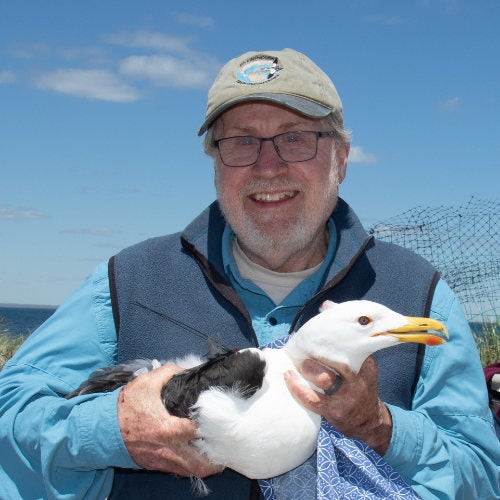- Professor Emeritus
- Department of Natural Resources Science
- Phone: 401.874.2986
- Email: ppaton@uri.edu
- Office Location: Coastal Institute, Room 110
Biography
Research
Dr. Paton’s research focuses on the conservation of vertebrate populations, with an emphasis on birds and amphibians. He is particularly interested in the impact of urbanization on vertebrates in New England. His recent avian research projects have included studies of the population ecology of neotropical migratory birds at a stopover site during fall migration, the effects of salt marsh restoration on Saltmarsh Sharp-tailed Sparrows, foraging habitat selection by wading birds in Narragansett Bay, and factors affecting plover populations along the coast. His research on pond-breeding amphibians has included movement phenology, assessment of techniques for monitoring population trends, investigation of the effects of landscape structure on population size, and assessment of the importance of within-pond and landscape-level habitat features on amphibian community structure.
Education
Ph.D., Utah State University, Wildlife Biology
M.S., Colorado State University, Wildlife Biology
B.S., Lewis and Clark College, Biology
Selected Publications
- Beuth, J. M., P. W. C. Paton, J. E. Osenkowski, and S. R. McWilliams. Body composition dynamics of common eider during winter: an application of the deuterium dilution method. Wildlife Society Bulletin 40:456-463
- Beuth, J. M. P. W. C. Paton, J. E. Osenkowski, and S. R. McWilliams. Validating the deuterium dilution method to measure body composition of common eider. Wildlife Society Bulletin 40:464-469
- Flanders, N. P., B. Gardner, K. J. Winiarski, P. W. C. Paton, T. Allison, and A. F. O’Connell. 2015. Key seabird areas in southern New England identified using a community occupancy model. Marine Ecology Progress Series 533:277-290.
- Smith, A.D., S.R. McWilliams, K.J. Winiarski, C.L. Trocki, B. Harris, J.E. Osenkowski, and P.W.C. Paton. 2015. Using land-based surveys to assess sea duck abundance and behavior in nearshore waters of southern New England, USA. Waterbirds 38:252-259
- Mayo, T. W., P.W. C. Paton, and P. V. August. 2015. Responses of birds to humans at a coastal barrier beach: Napatree Point, Rhode Island. Northeastern Naturalist 22:501-512.
- Koch, S. L. and P.W.C. Paton. 2014. Assessing anthropogenic disturbances to develop buffer zones of shorebirds using a stopover site. Journal of Wildlife Management 78:58-67.
- Loring, P. P.W.C. Paton, J. Osenkowski, S. Gilliland, J.P. Savard, S.R. McWilliams. 2014. Habitat use and selection of Black Scoters in southern New England and siting of offshore wind energy facilities. Journal of Wildlife Management 78:645-656.
- Smith, A.D., P.W. Paton, S. R. McWilliams. 2014. Using nocturnal flight calls to assess the fall migration of warblers and sparrows along a coastal ecological barrier. PLoS ONE 9: e92218. doi:10.1371/journal.pone.0092218.
- Winiarski, K. D.L. Miller, P.W.C. Paton, S.R. McWilliams. 2014. A spatial conservation prioritization approach for protecting marine birds given proposed offshore wind energy development. Biological Conservation 169:79-88.
- Winiarski, K., M.L. Burt, E.A. Rexstad, D.W. Miller, C.L. Trocki, P.W.C. Paton, S.R. McWilliams. 2014. Integrating aerial and ship surveys of marine birds into a combined density surface model: A case study of wintering Common Loons. Condor 116:149-161.
- Winiarski, K., D.W. Miller, P.W.C. Paton, S. R. McWilliams. 2013. Spatially explicit model of wintering common loons: conservation implications. Marine Ecology Progress Series 492:273-283.
- Loring, P., P.W.C. Paton, R.A. McKinney, C.A. Oviatt, and S.R. McWilliams. 2013. Densities of wintering scoters in relation to benthic prey assemblages in a North Atlantic estuary. Waterbirds 36:144-155.
- Osenkowski, J. and P.W.C. Paton, and D Kraus. 2012. Using long-term constant effort banding data to monitor population trends of migratory birds: A 33-yer assessment of adjacent banding stations. Condor 114:470-481.
- Golet, F.C., D.H.A. Myshrall, L.R. Oliver, P.W.C. Paton, and B.C. Tefft. 2012. Role of science and partnerships in salt marsh restoration at the Galilee Bird Sanctuary, Narragansett, Rhode Island. Pages 333-353 in Tidal Marsh Restoration: A synthesis of science and management (C.T. Roman and B.M. Burdick, eds). Island Press. Washington, D.C.
- Shumchenia, E.J., S.L. Smith, J. McCann, M. Carnevale, G. Fugate, R.D. Kenney, J.W. King. P. Paton, M. Schwartz, M. Spaulding, and K.J. Winiarski. 2012. An adaptive framework for selecting environmental monitoring protocols to support ocean renewable energy development. Scientific World Journal Doi:10.1100/2012/450685.
- Cook, R., T.A. Tupper, P.W.C. Paton, and B. Timm. 2011. Temporal variation in anuran detection probabilities at Cape Cod National Seashore: Implications for long-term monitoring. Herpetological Conservation and Biology 6:25-39.
- Smith, S.B. and P.W.C. Paton. 2011. Long-term shifts in autumn migration by songibrds at a coastal eastern North American stopover site. WILSON JOURNAL OF ORNITHOLOGY 123:557-566.
- Raithel, C. J., P.W.C. Paton, P. S. Pooler, and F.C. Golet. 2011. Assessing long-term population trends of wood frogs using egg mass counts. Journal of Herpetology 45: 23-27.
- Bauer, D., P.W.C. Paton, and S.K. Swallow. 2010. Are wetland regulations cost-effective for species protection? A case study of amphibian metapopulations. Ecological Applications 20: 798-815.
- Bauer, D.M., S.K. Swallow, and P. W. C. Paton. 2010. Cost-effective species conservation in exurban communities: a spatial analysis. Resource and Energy Economics 32: 180-202.
- Curtis, A.E. and P.W.C Paton. 2010. Assessing detection probabilities of larval amphibians and macroinvertebrates in isolated ponds. Wetlands 30:901-914.
- McKinney, R.A., and P.W.C. Paton. 2010. Breeding birds associated with seasonal pools in the northeastern United States. JOURNAL OF FIELD ORNITHOLOGY 80:380-386.
- Paton, P.W.C., Harris, R.N. 2010. Egg mass and nest counts. In: Amphibian Ecology and Conservation, p. 282-298. Dodd Jr., C.K., Ed., Oxford University Press, New York
Course
- Field Ornithology (NRS 304)
- Wetland Wildlife Management (NRS 406)
- Management of Migratory Birds (NRS 505)

